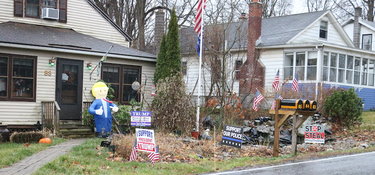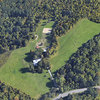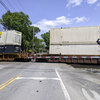Voorheesville looks to update zoning with an eye toward village-wide sign regulation
VOORHEESVILLE — Two years after it was first alerted to political signs being up weeks after the 2020 general election, the village of Voorheesville has proposed a local law that would treat all temporary signs the same way.
A public hearing on the proposed law was held on Jan. 25, while a vote on the bill is likely to happen in the coming weeks.
During their late November 2020 meeting, Voorheesville trustees learned about residents’ calling to complain that political signs were still posted three weeks after the general election.
Then-Mayor Robert Conway said to the village’s attorney, Richard Reilly, “There’s really not a time limit on signage of that sort.”
The United State Supreme Court in a 1971 decision concluded that local governments could not restrict an individual’s speech based on “its message, its ideas, its subject matter, or its content.”
Nearly 45 years later, the Supreme Court expanded on that 1971 decision, ruling governments couldn’t base decisions about how long temporary signs are allowed to stand based on the date of an event, because that would require reading the sign — which means a municipality would be making its decision about the location and length of time a sign is allowed to be posted based on what the sign itself says, which the Supreme Court in 2015 in Reed v. Town of Gilbert Arizona, said was government regulating speech.
Voorheesville has had a law its on books for decades that states, “Political signs or posters of not more than thirty-two (32) square feet in area shall be permitted within the Village provided they are not displayed more than four weeks before the relevant election day and removed no later than three (3) days after the election date.”
Along with a few other zoning tweaks, Local Law Number 2 of 2023 eliminates the definition of political signage from village law and in its place proposes limiting the number of signs placed on a parcel to two, and their area to not more than six square feet. Nor shall temporary signs be allowed in any right-of-way.
Public hearing
During a Jan. 25 public hearing on the proposed law, resident April Moore noted that political signs had been struck from the village code. “And we’ve heard that you can’t have it in there, [but] I don’t know if other towns in the area allow it,” Moore said.
She also said that she and her husband, Lance, a former member of the New Scotland Zoning Board, are constantly subjected to cars beeping as they drive by one house whose “signs [had been] there for too long.”
With it being so far outside of election season, she said, “it would seem nice to have them removed,” which they were.
But, she said, “It was constant, with the signs that stay up.”
Moore said she didn’t know if the section of the zoning law on political signs had to be removed, “or if it can be looked at again.”
Reilly responded that the language relating to political signs has been “there, as long as I can remember,” but it’s an issue that’s “been flagged for us.” The statute governing political signs in the village has been on the books since at least 1984, when Voorheesville adopted a revised zoning law that included the rule.
Reilly explained village oversight of signs “needs to be content neutral.”
“And so we recognize some residents’ concerns about a sort of proliferation of temporary signage that stays there forever,” Reilly said. “But we also want to be cognizant of the fact that there are some First Amendment protections that we really don’t want to run afoul of.”
Reilly said he thought removing the definition of political signage from the village code wasn’t “necessarily the final sign law that we want to have in place,” but as a first step, “when we were going through trying to clean up some other issues in the zoning code, we did just want to eliminate ... the clear problem that was presented by the political signage.”
By regulating signs in a “content-neutral way,” Reilly said, like mandating how many and how large, the village should be able to keep itself out of any thorny debates.
At its upcoming Feb. 15 workshop, which typically starts at 6 p.m., it’s likely the board will vote on the proposed law’s adoption, Reilly said, but trustees did vote to keep the public hearing open for written comment.
Regulating speech?
Reilly was asked by The Enterprise how eliminating the definition of political signage and choosing instead to regulate all temporary signs based on their square footage and sum total wasn’t the village regulating speech by other means.
“So we can regulate in a non-kind-of-content-neutral manner,” he said.
In the past, Reilly said, Voorheesville specifically identified political signs as something that could only be up for a certain number of days before and after an election. “Now we’re simply saying that there’s a limit on the number of temporary signs a property could have, there’s a limit on the size of those temporary signs, and there’s a limit on the location where they can be maintained.”
Melanie Trimble, the director of the Capital Region Chapter of the New York Civil Liberties Union, in November 2020 was asked by The Enterprise if the village could regulate all signs, so as not to appear to be targeting just the political ones. Trimble said that the First Amendment has a “carve-out” for freedom of expression, and that there is a “distinct difference” between a commercial and political sign.
Trimble said that, if the village were to adopt zoning regulating the size and sum of signs it would “never be able to carve out or regulate political signage on someone’s personal property,” because it would violate the Constitution.
“It’s been tried before,” she said of municipalities trying to regulate political signs while trying not to appear to be regulating political signs.
The 2015 Supreme Court decision forced local governments still in the hunt to regulate speech to meet a higher judicial-review threshold, known as “strict scrutiny,” the idea that proposed anti-constitutional law is needed “to promote a compelling interest” and is “the least restrictive means to further the articulated interest.”
But the court, in the opinion of the New York Department of State, left open a door for regulation, “opin[ing] that its decision will not prevent governments from enacting effective sign laws.
“Local governments have ample content-neutral options available to resolve problems with safety and aesthetics, including regulating size, building materials, lighting, moving parts, and portability,” according to sign guidance put out by the Department of State. “Municipalities may still be able to forbid postings on public property, so long as it does so in an evenhanded, content neutral manner.”
The state is not alone in its opinion.
A question-and-answer guide from the ACLU of Massachusetts states, “There can be limits on your right to display yard signs.
“Unlike oral speech, signs take up space and may obstruct views, distract motorists, displace alternative uses for land, and pose other problems that legitimately call for regulation. It is common ground that governments may regulate the physical characteristics of signs — just as they can, within reasonable bounds and absent censorial purpose, regulate audible expression in its capacity as noise.
“Municipalities may have reasonable, content-neutral laws that apply to all signs. For instance, a town may require the signs to be no larger than certain dimensions and be placed in a manner so as not to impede visibility on the roads by motorists.”


